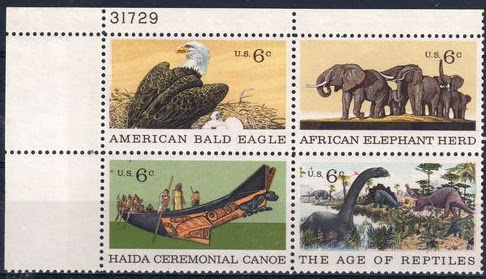The name "Bald Eagle" is what amused me when I first saw this beautiful bird. "Bald" in the English name is derived from the word PIEBALD, and refers to the white head and tail feathers and their contrast with the darker body.
All the facts about this bird are very intriguing and when one sees this majestic bird one can truly say that it is a contender to be considered to rule the air.
The Bald Eagle is a carnivore with the capacity to predate a great variety of prey. Throughout their range, fish often compromise the lion's share of the eagle's diet. That is why they are mostly found near the seacoasts, rivers, large lakes or marshes or other large bodies of open water with abundant fish .
The Bald Eagle is important in various Native American cultures and, as the national bird of the United States, is prominent in seals and logos, coinage, postage stamps, and other items relating to the U.S. federal government.
 |
| USA 6 cents Bald Eagle(upper left corner ) from the 1970 set. |
The Best Stamp in my collection is the 22 cents Bald Eagle which is part of the North American Wildlife stamp set .
 |
| An experienced trained handler with the Bald Eagle. |
I had been to the Andover Hawk Conservancy and when I saw this bird, it was just awesome ; I did manage to get very close to it. The Bird handler spoke well of the bird and shared his experience with it. You could see the joy that glistened in their eyes in the photograph above .


































